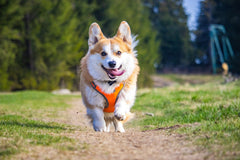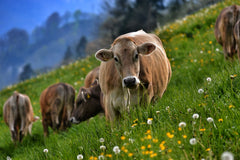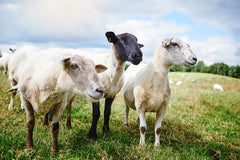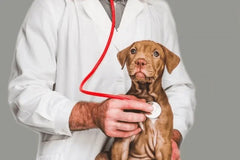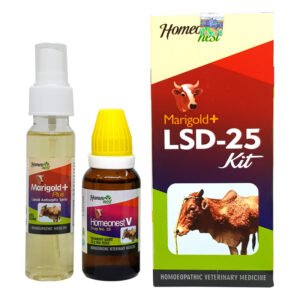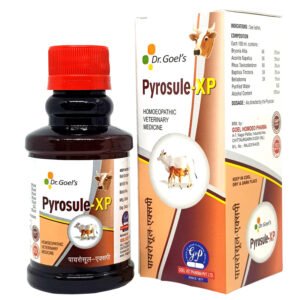
Heat Stress in Cattle: Causes, Symptoms, Prevention and Treatment
Global warming has led to an increased incidence of heat stress in dairy cows in many countries. In most parts of India where the ambient temperature is high, the farmer must provide appropriate living conditions that provide protection from excessive heat during the summer months. Dairy cattle cannot dissipate their heat load efficiently. They have a poor sweating mechanism, and they rely on respiration to cool themselves. A cow also needs to disperse additional heat produced during the fermentation process within the rumen. Because they cannot effectively dissipate heat load, they dissipate heat accumulated during the day at night.
Heat stress also affects milk production and composition, including milk protein and butterfat content.
Heat stress has an adverse impact on feed consumption and milk production. Heat stress does not only depend on ambient temperature but is also associated with humidity and air movement. As the humidity increases, the cow’s evaporation is reduced, and she cannot cool herself. This increases the core body temperature and greatly depresses feed intake.
Heat stress refers to a state where animals are not able to cope with excessive heat load (EHL). For the normal functioning of various tissues and organs within the body, it is important that body temperature be maintained within a relatively narrow range. If the animal cannot tolerate the raised body temperature, there may be organ dysfunction and even death. Failure of an animal’s thermoregulatory system in response to excessive heat load is termed “heat stress.” Animals maintain their body temperatures within a narrow range. It is achieved mainly by influencing metabolic heat production and evaporative heat loss.
A major source of heat accumulation is endogenous heat production due to physical activity, digestion, and other processes like inflammation. Additional heat is obtained from the sun, nearby structures that emit heat, and the hot air that surrounds us.
Animals dissipate body heat by convection, conduction, radiation, and evaporation.
Convection: the loss of body heat when the surrounding air is warmed by skin contact.
Conduction: When heat is transferred to a cooler surface in direct contact with the skin,
Radiation: heat moving away from the body into the surrounding atmosphere
Evaporation: is the removal of water from the body’s surface.

Evaporative and convective cooling are the major means of body heat loss. Panting increases air flow across the respiratory mucosa, and convective and evaporative cooling take place.
Excessive heat load may result due to environmental conditions such as rainfall, high temperatures, high relative humidity, and adverse climatic conditions.
Animal factors that result in excessive heat load include breed, coat type (dark and woolly coats may be more likely to gain heat), body condition (fat animals accumulate more heat), and lack of adaptation to heat. Bos indicus cattle are naturally more heat-tolerant compared to most Bos taurus breeds. Diets that are rich in fermentable carbohydrates or proteins will generate more metabolic heat. Because metabolic heat production increases during and after feeding, feeding animals during cooler times of the day may help avoid overheating.
Temperature and humidity gradients determine the heat flow from the animal. If the surrounding temperature is lower than the animal’s body temperature, then heat loss mechanisms can operate to move heat from the animal to the environment.
Evaporation of water from the body’s surfaces, such as the skin or respiratory tract, leads to evaporative cooling. Evaporative cooling through sweating and panting becomes the major form of heat loss when the temperature exceeds 21 °C, and if the environmental temperature equals or exceeds an animal’s body temperature, then evaporative heat loss is the only available heat loss mechanism for animals to regulate body temperature.
When the body temperature is higher than the surrounding air temperature, heat loss from the cattle’s skin via convection and evaporation is more common. Mechanical ventilation helps in evaporative heat loss by ensuring continual air flow over the animals. Forced air flow ensures that higher-humidity air is moved away from the animals and replaced with lower-humidity incoming air, ensuring evaporative cooling.
Temperature and the relative humidity of the air influence the evaporation of water from the surface. In hot, dry conditions, evaporative cooling becomes the most important medium for heat loss. However, as relative humidity rises, there is less potential for the air to absorb more water vapor, and when relative humidity is 100 percent, the air is saturated and additional evaporation cannot occur.
Animals generally accumulate heat during the hottest part of the day and release it during the cooler parts of the day. Animals are not able to lose heat if the environmental temperature remains high for most of the day and night, and they may gradually accumulate excessive heat over time.
Long periods of very high environmental temperatures for much of the day and night, combined with high humidity, favour heat stress during export voyages. These conditions may reduce the animals’ ability to lose heat, and severe heat stress conditions may rapidly develop.
Heat stress can result in a reduction in food intake, depression, and an increased heart and respiratory rate. Panting and open-mouth breathing predispose topneumonia. A continued rise in body temperature will eventually result in respiratory and circulatory failure and death.
Heat stress is one of the most important concerns of the livestock export industry.
During the export of animals, heat stress usually occurs at assembly points on extreme summer days, at sea when crossing across the equatorial regions, or when ventilation systems fail.
Heat stress costs you money.
- Heat-stressed lactating cows have reduced dry matter intake and milk production.
- Heat stress also leads to increased lameness, disease incidence, and death rates.
- Heat-stressed late-gestation cows have shorter gestation periods, calves with lower birth weights, reduced milk production, and impaired immunity.
- Heifer calves from heat-stressed cows produce less milk for the first 30 weeks of lactation.
When do cows start to become heat-stressed? Cows begin to experience heat stress at much lower temperatures than humans. In general, mild heat stress starts around 72°F with 50% humidity.
High-producing cows eat more and generate more heat. They can begin to experience heat stress in well-ventilated houses at a temperature of 65 °F.
| Heat stress level | Temperature and humidity index (THI) | Respiration (breaths per minute) | Body temperature (degrees Fahrenheit) |
|---|---|---|---|
| No heat stress | less than 68 | 40-60 | 101.5-102.5 |
| Mild | 68-71 | 60-75 | 102.5-103 |
| Mild to moderate | 72-79 | 75-85 | 103-104 |
| Moderate to severe | 80-90 | 85-100 | 104-105 |
| Severe | 90-99 | 100-104 | Over 105 |
The temperature-humidity index (THI) takes into account both temperature and humidity to estimate the level of heat stress cows will experience based on environmental conditions.

Symptoms:
Physical appearance:
- Cows with mild heat stress may not show any clinical signs.
- Cows suffering from severe heat stress pant with an extended neck and breathe with their mouths open.
Respiration rates:
Under farm conditions, it is preferable to measure heat stress in terms of respiration rates rather than body temperature because it is less disruptive to cows.
- 40 to 60 breaths per minute (bpm) is the normal respiratory rate for adult dairy cattle.
- If more than 10% of cows have a respiratory rate exceeding 100 bpm, then it’s an alarming situation, and appropriate measures should be taken.
Body temperature:
Body temperature is directly proportional to a cow’s heat stress level.
- The normal body temperature for an adult cow is 101.5 to 102.5 degrees F.
- If more than 5–10% of cows have a body temperature above 105 degrees F, the situation is considered an emergency, and immediate action should be taken.
Milk production:
An increase in the level of heat stress decreases milk production.
- Mild heat stress results in a production decrease of about 2.5 lbs. per head per day.
- Mild to moderate heat stress results in a production decrease of about 6 lbs./head/day.
- Moderate to severe heat stress results in a production decrease of about 9 lbs. per head per day.
- Severe heat stress is a life-threatening condition, and production decreases exceed 10 lbs./head/day.
Preventing heat stress:
Shade and ventilation are important things to keep in mind. For some reason, cows like to gather together when it is hot, and to prevent this, proper shade must be provided to them, as if there is only one tree, then they will all try to stand under it for shade. An area under one or a couple of trees will create more health problems than no shade at all. If good tunnel ventilation is provided in barns, it is advised to keep the cows in during the day and let them out at night or during cooler parts of the day to graze. Cows will graze much better in the early morning and cooler evenings than during the bright daylight hours when it is too hot. Reduce the amount of high-carbohydrate/starchy rations (i.e., grains) fed during hot spells because they tend to “heat up” the rumen in general, and instead feed haylage or grass silage, hay, and evening grazing.Because oats are a cooler food, they can be fed. A diet with a lower dry matter intake and increased nutrient density should be fed to the animal. Yeast probiotics can be added to the diet to reduce the negative impact of heat stress. It reduces the respiratory rate and increases milk production.
Without doubt, tunnel ventilation provides a much more comfortable environment for both the cows and the workers. Cows can become very uncomfortable if they are kept inside the whole day without either tunnel ventilation or shade. Also, having really big cows can cause problems in the summer because of the heat generated internally by the metabolism produced by very rich rations. These cows really need tunnel ventilation and/or big fans.
Most intensively grazed cows should be taken out for grazing during cooler parts of the day as they have less fat, so metabolic heat is minimal and their comfort during grazing should be kept in mind. Breed, like fat, has no effect on cattle’s susceptibility to heat stress. Fatty animals suffer more in heat. Big, fatty cows are affected more than cross-bred cows and leaner cows.
Tunnel ventilation also protects the animals from flies, as they cannot fight the air current. Even if you don’t have tunnel ventilation, it may be better for your animals to keep them around the barnyard, protecting them from direct sunlight. Overhead fans or large box fans can be used to keep animals cool. Installing a curtain on the barns allows the breeze from outside to enter the barn. Keeping the animals in for the least amount of time is the goal of most graziers. During the hottest months, the smartest measure is to keep animals inside with fans and take them out at night for grazing.
For calves in hutches, the back of the hutch should be held off the ground during hot days by placing a brick or something to give it support. This will give a nice ground flow of air circulation, which will greatly help keep the animal cool.
Heat-tolerant animals should be identified through genetic selection for the alleviation of heat stress in cattle and buffaloes.
Fresh and cool water should be available to the animals at all times. During extreme heat, an additional water source should be created.
Environmental management is a very important skill for our farmers. Although weather cannot be controlled, the areas where cows inhabit can be easily controlled to help prevent potential disasters in the heat of summer.

Treatment of heat stress in homeopathy:
PREVENTO for CATTLE – 100 ml

Indications:
PREVENTO for CATTLE is for large animals showing panting due to sun stroke, heat stroke, excessive cold, or after recovering from foot and mouth disease.
This unique formulation is brought up by the leading Homeopathic Veterinary Medicine producing company Goel Vet Pharma Pvt Ltd. The company is certified under WHO GMP practices which highlight its hygienic manufacturing facilities. All the available formulations had undergone many clinical and field trials thus gaining trust among many veterinarians and pet parents.
DRUG DESCRIPTION
Homeopathic remedies work on the principle of “similia similibus curanter” which means “like cures like”, so is PREVENTO. Hence, such formulations that cause symptoms like a diseased animal in a healthy one are used to prepare this wonder drug formula to be able to treat urinary tract infections of varied reasons. It is a formulation that is developed by a renowned Indian veterinarian after consulting many homeopaths and conducting advanced field trails over the years. It has gained the trust of thousands of veterinarians and livestock farmers with its remarkable results without any side effects or contraindications.
INDICATIONS:
PREVENTO for CATTLE is for large animals showing panting due to sun stroke, heat stroke, excessive cold, or after recovering from foot and mouth disease.
DOSAGE: 5-10 mL 3 times a day or as directed by the veterinary doctor.
PRESENTATION: 200 mL bottle
HOMEOPATHIC DRUGS USED IN THE FORMULATION
Quality, efficacy, and safety are the utmost priorities of URIGO formulation. Cost-effective health care with no contraindications or side effects are the added benefits of using a homeopathic remedy. Facts about the homeopathic medicines used in this formulation
Natrum Mur 30:
Respiratory debility due to excessive heat or cold, dry mucus membranes with constrictive sensation throughout the body, fever all the day, nausea, vomiting, increased thirst, profuse sweating, inflammation of the frontal sinuses, and other related symptoms can be treated with this drug.
Gloninum 200:
Hyperaemia of the brain due to exposure to excessive heat or cold, headache, sunstroke, irritability, surging of blood to head and heart, violent convulsions, dyspnoea are some of the symptoms that can be recovered with this homeopathic remedy.
Natrum Carb 200:
This remedy can be used to treat increased anxiety, restlessness, vertigo from prolonged exposure to the sun, headache due to hot weather by stimulating cellular activity and increasing oxidation and metabolism at the cellular level. Debility caused by summer heat, chronic effect of sunstroke, exhaustion, anaemia, dry skin, weak ankles, etc., can be addressed with this drug.
Aconitum Napellus 30:
It can be used as a first and foremost remedy to treat inflammations, inflammatory fevers, sudden illness, aches, colds cough, sore throat, flu, chills, and fever. Complaints related to exposure to dry, cold weather, or hot weather, especially gastro-intestinal disturbances, increased perspiration, etc., can be addressed. A state of fear, anxiety, anguish of mind, and body, physical and mental restlessness, acute, sudden, and violent invasion with fever, sudden weakness and loss of strength can be improved with this drug.
Exhaustion even after a slight exertion, debility, restlessness aggravating during night are the most important symptoms that can be treated with this drug. Severe pain in the throat with unquenchable thirst, constricted air passage, suffocative catarrhal inflammation in the throat, cough worsening after midnight or while lying on the back, wheezing respiration, cough dry as from Sulphur fumes are the symptoms that can be treated with this drug.
Note: All the above mentioned symptomatic description of the homeopathic drugs is taken from approved literature of homeopathy with an underlying base from Homeopathic Pharmacopeia of India.
Dosage: 5 mL, 3-4 times in a day or as directed by the veterinary doctor.
Presentation: 200 ml
Contraindication: No known contraindications.
Homeopathic Solutions For Cow and Buffalo
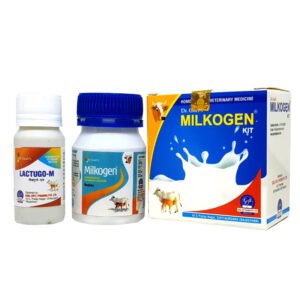 MILKOGEN KIT for Increasing Milk in Punganur Cow
MILKOGEN KIT for Increasing Milk in Punganur Cow
MILKOGEN Kit is an excellent Homeopathic Veterinary Medicine used in Cows and Buffaloes to increase milk yield naturally. It is a natural replacer of oxytocin hormone without any contraindications or side effects but with a definite increase in the milk yield. It increases the milk quantity and fat percentage of the milk to the full potential of an animal.
TEATASULE FIBRO GOLD KIT For Mastities Issue In Punganur Cow
TEATASULE FIBRO GOLD KIT is the best Homeopathic Veterinary Medicine for female animals in the case of chronic and clinical mastitis. TEATASULE FIBRO GOLD KIT is very effective in case of chronic or clinical mastitis when the udder is as hard as a stone, teats are shrunk with fibroids developed in the teats, and in teat cracks.
Marigold+ LSD-25 Kit For Lumpy Skin Diseases
Marigold+ LSD-25 Kit is For boosting immunity against LSD and other similar viral diseases. It is a Homeopathic Treatment of Lumpy Skin Disease (LSD) in cattle with oral medicine for enhancing internal Immunity and Healing Spray for treating external wounds.
Pyrosule-XP for High Fever in Cattle
PYROSULE-XP for CATTLE is the best Homeopathic Veterinary Medicine for Cattle that protects animals from infection. PYROSULE-XP relieves muscular and nervous pain that occurs during a fever and even decreases the severity of the fever.
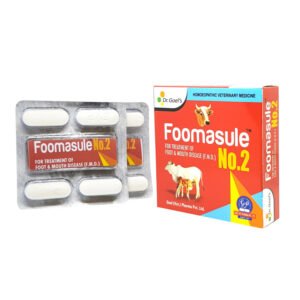 FOOMASULE NO. 2 for Foot and Mouth Disease
FOOMASULE NO. 2 for Foot and Mouth Disease

ProlapsGo For Prolaps Problem In Cattle
PROLAPSGO for cattle is the best Homeopathic Veterinary Medicine for Pre-partum or Post-partum prolapse of the uterus in cows & buffaloes. PROLAPSGO gives fast and long-lasting relief in case of prolapse of the uterus in cows and buffaloes. It can be sprayed directly over the prolapse of the uterus and can also be administered orally.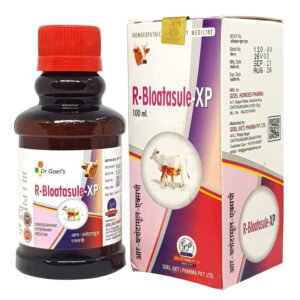
R.Bloatasule-XP For Bloating Issue in Cattle
R. BLOATASULE XP is the best Homeopathic Veterinary Medicine that is helpful for the treatment of indigestion, anorexia, and liver disorders.Check out: – GOHEAL SPRAY
Check out: – HEMISEPT for CATTLE – 100ML



